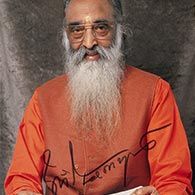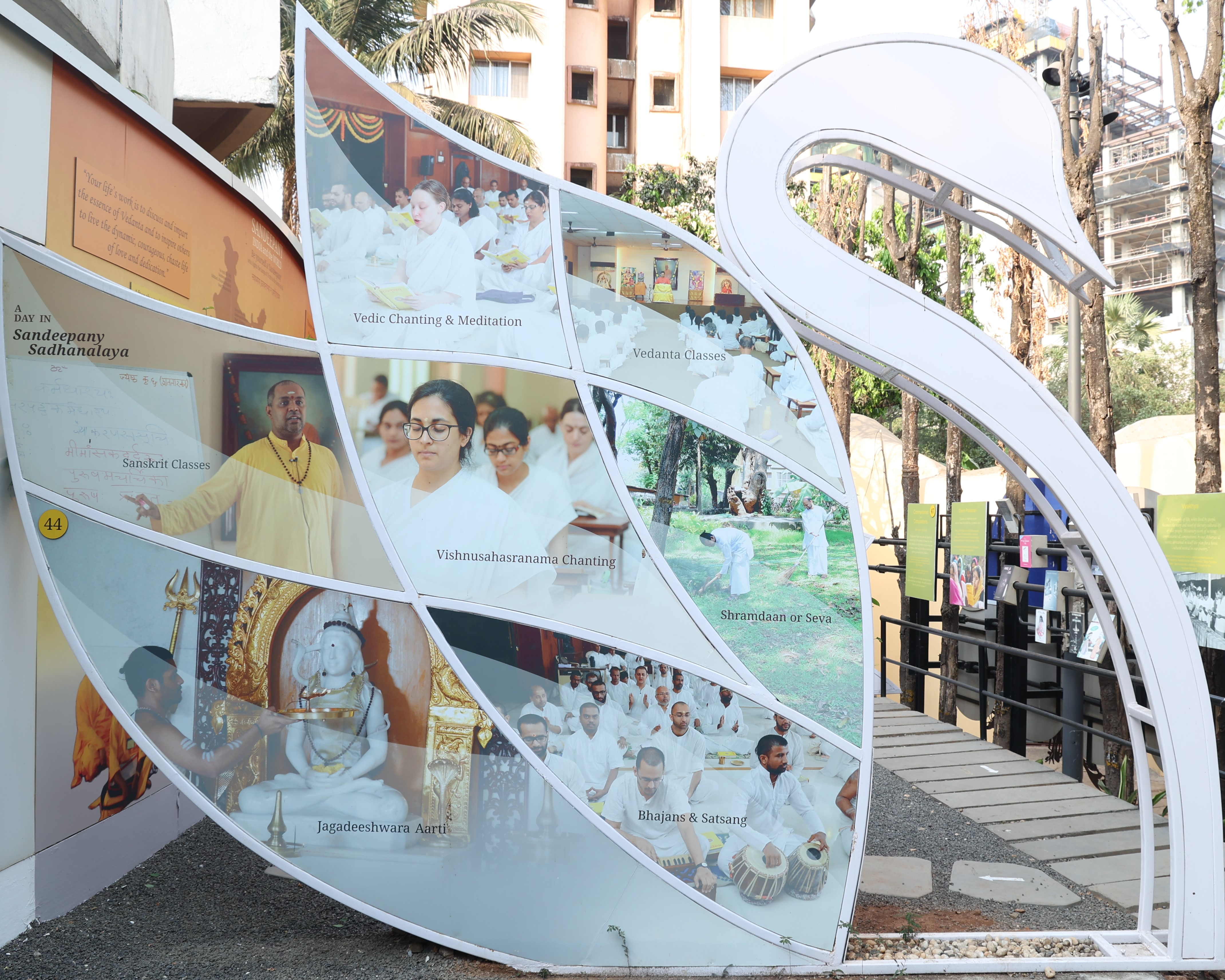A day in Sandeepany is depicted in the Swan Installation from morning Vedic Chanting till Evening Satsang The detailed schedule is given below.
4.00am - Wake up Bell.
5.30am to 6.00am - Vedic Chanting & Aarti
7.00am to 8.15am - Vedanta Class 1
8.15am to 9am - Breakfast
10am to 11.30am - Sanskrit
12noon to 12.20 - Vishnusahasranama Chanting / Naam - Sankirtan
12.30pm - Lunch
3.30pm - 4.30 pm - Vedanta Class 2
4.45pm - 5.30pm - Shramdaan or Seva
6.30pm - 6.50pm - Temple Aarti
7pm - 8.15pm - Bhajans & Satsang
8.30pm - Dinner
Syllabus:
The curriculum of the Vedanta Course is well-rounded to develop both the head and the heart of the students.
Since the focus of the exhaustive curriculum is Advaita Vedanta, the primary trio of the Hindu scriptures called the Prasthana-Trayi is studied. These are the major Upanishads, Bhagavad-gita, and Brahma-sutras, and they are examined using Adi Shankaracharya’s detailed commentary on these texts. To aid understanding and provide greater depth to their knowledge, students are also taught Sanskrit grammar. Training in Vedic chanting, particularly the various Suktams and the Vishnu Sahasranama, are incorporated in the daily routine. As students have to soar high on the wings of both knowledge and devotion, the coursework also includes an in-depth study of devotional texts and hymns composed by great spiritual masters.
Texts that introduce and inspire: Tattva Bodha, Bhaja Govindam, Atma Bodha, Upadesha Sarah, Sadhana Panchakam, Panchadashi (Ch. 5, 10, 15), Vivekachudamani, Drg-Drshya Viveka, Aparokshanubhuti, Vakya Vritti, Advaita Makaranda, Vedanta Sarah, Sad-Darshanam, Vedanta Dindima, Hastamalaka Stotram, Nirvana Shatkam, Maneesha Panchakam, Shivapradhakshamapana Stotram and Dakshinamurti Stotram
• Shrimad Bhagavad-gita fully. All 18 Chapters with the commentary of Sri Adi Shankaracharya.
• The Upanishads: Isha, Kena, Katha, Mundaka, Aitareya, Taittiriya, Prashna, Mandukya with Karika, Chandogya (Ch. 6-8), Kaivalya, Amrta-Bindu and Shvetashvatara. Brihadaranyaka is not taught.
• Brahma Sutras (Sutras 1-4)
• Devotional Texts and Hymns (some studied in-detail; some in general, with select verses): Shrimad Bhagavatam, Tulsi Ramayana (Ramacharitamanasa), Adhyatma Ramayana, Valmiki Ramayana, Vishnu Sahasranama, Narada Bhakti Sutra, Hanuman Chalisa, Mukunda Mala, and Madhurashtakam and other devotional compositions.
• Other Texts: Yoga Vasishtha, Tapovana Shatkam, Purusha Suktam, Jivanmuktananda Lahari, Manah Shodhanam, Bhakti Sudha, Dhyanasvarupam, Maya Panchakam, Kaupina Panchakam, Svarupa Anusandhana Ashtakam, and Dhanyashtakam.
Apart from the above:
Original composition of Saints like Bhagavan Ramana Maharshi, Sant Jnaneshwara, Swami Vidyaranya, Samartha Ramdas etc
. Sanskrit - from alphabets onwards till the working knowledge of Sanskrit.
Vedic Chanting
Meditation
Innovative ways of Festival Celebrations
Public Speaking
Bhajan and Kirtan
"In this work of yours, if your sadhana is not continuous, you will be unnecessarily wasting your time, the public's time, and the public's money. Your words will have no effect at all unless you are regular in your contemplation, meditation and private study.” -Swami Chinmayananda
As one walks through the Swan Installation, the curved surface 3 depicts the Missionary aspect of Sandeepany.
Design Notes
Guru-Parampara & One Day in Sandeepany
The second sub-section represents the Guru Parampara followed by the institute through a visual montage panel. The swan in a stylized form is used for the installation, which gives an insight into the daily schedule from morning to evening.



